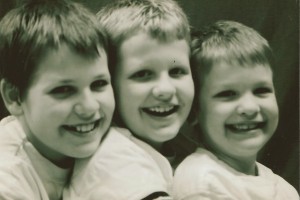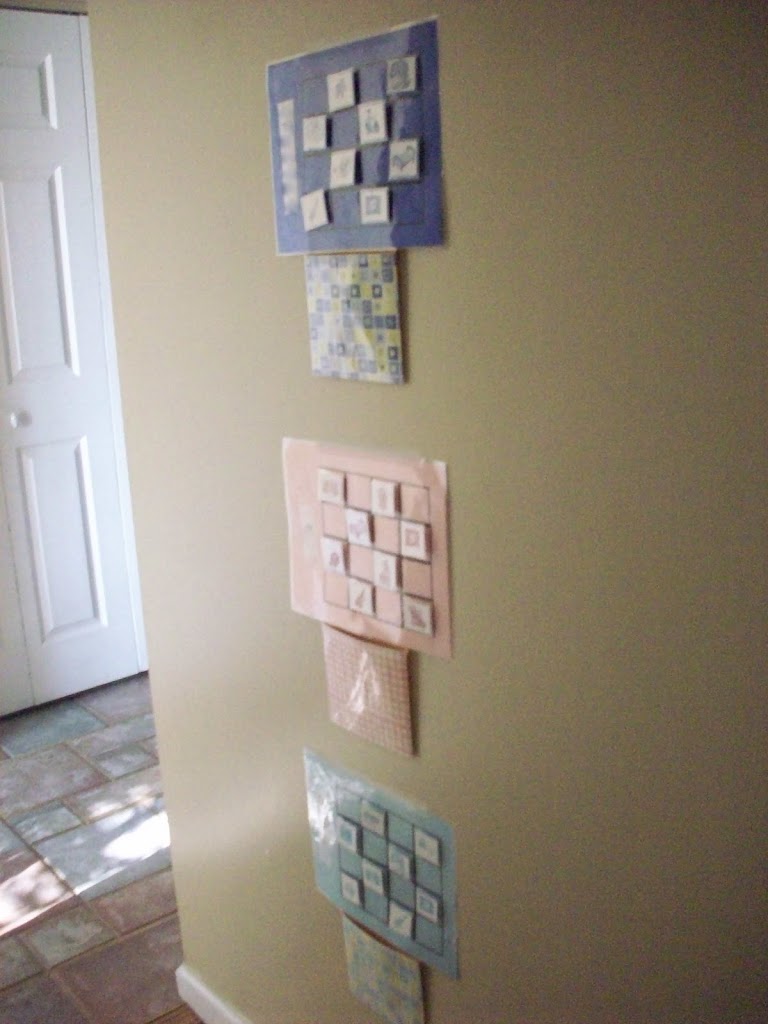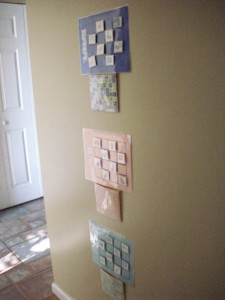by Donna | Jan 21, 2010
“The only moral lesson which is suited for a child, the most important lesson for every time of life, is this: ‘Never hurt anybody.’”
Denis Breeze
A question that we get asked a lot is “How do you get your kids to NOT fight?” Obviously, there are dozens, if not hundreds, of little things that go into siblings getting along. I would never pretend that our children always got along perfectly—or that they never had “their moments.” They are really good friends—both those at home and those who are grown, but seven kids and two parents living in one small fourteen hundred square foot house allowed for a lot of, well, relationship training! When our children didn’t get along, we tried to use the opportunity as a teachable moment, a time to instruct in interpersonal skills, problem solving, deferring, Christian character, and more.
However, one thing that we emphatically taught them concerning each other—from very young ages—is that you are not allowed to strike your sibling. I am sure that they did hit each other on occasion—or that “playing” got out of hand and what started as “normal” living room tackles became real pushes and shoves in anger, but I can’t say that I remember them, even as preschoolers, harming one another.
I think the whole not “striking your sibling” thing has to have three components to ward it off: (1) from the beginning of the child’s early memory, it needs to be ingrained within them that under no circumstances are they allowed to hurt others (siblings or otherwise); (2) it must be a “biggie”; in other words, it can’t just be a passing “don’t do that” or “go sit in the corner for that,” but instead must be a huge deal in your home, right up there with lying and other “biggies”; (3) it must be punished consistently if it occurs (while making a “big” deal out of this “biggie”).
Since this is a Positive Parenting blog, intent to give suggestions on Positive and Preventive Parenting, as opposed to Corrective Parenting, I will leave number three of the list above up to your personal discipline style. The other two, however, are taught through consistency and empathy training. Consistency in keeping appropriate behaviors in the forefront of their minds and hearts—and consistency in discussing these things all the time (as well as consistency in discipline). And empathy training by putting within their hearts that we must think of how others feel at all times.
I liken enforcement of the “biggies” of Christian parenting (lying, striking, disrespect, cheating, stealing, etc.) to a carseat analogy. People always say that they cannot “get” their kids to do something or to stop doing something, such as in the hitting scenario. However, those same parents somehow got their infant, then their toddler, to sit in a car seat every single, solitary time that child was riding in a vehicle. How could that be? Didn’t the child want out? Didn’t the toddler scream and throw fits? Didn’t you have to let him out and allow him to sit where he wanted to in order to have peace?
Of course, the answers to those questions are obvious ones. The child stayed in the car seat while traveling in the vehicle because there was simply no other choice. The same thing can be true of anything that is important to you in your parenting. If you truly want hitting (or lying or any negative behavior) to end, you must make it non-optional, just like you did staying in the car seat.
While I certainly do not agree with the above quote that the only lesson a child needs is not to hit someone, I do agree that ONE of the “most important lessons for every time of life, is this: ‘Never hurt anybody.’”

by Donna | Jan 19, 2010
 |
| When “littles” have routines and consistency, every day can be a joy! |
Yesterday I introduced the concept of the morning routine for all children. Today I would like to spend time on helping parents develop morning routines for their preschoolers. Tomorrow I will address older children and teens in this area.
I mentioned that a mom at a parenting seminar taught us about morning routines when we only had first graders and under. As she explained developing this routine, she showed her littles’ morning routine chart—a darling “board game” that she made on half sized poster board with every other square of the “Candyland” type of board containing a picture of something that the child needed to do in the morning—a child dressed; a child making his bed; a child putting his pj’s away; etc. It was so sweet—and we came home and promptly made “morning routine board game charts” for all of our kids who were old enough to follow the board and do a morning routine. (We used little people/animals with that tacky stuff placed on the bottom of them for the child to take around the board as he does his morning routine. These boards hung on the refrigerator, so it was important that the little pieces were lightweight and stuck well when the child put them on a square.)
Here are some additional tips for implementing morning routines with your little ones:
1. Timing each activity before setting the morning routine time is more important with this age group than any other. Small children can get discouraged if things seem to take too long—and a timer and reporting back to you while developing the time for the morning routine will help him see that this morning routine is truly doable.
2. Consider making a game board like the one described above, with pictures of children on them for your non-readers. (We wrote the task at the bottom of each picture, so the child had the picture as well as the words.)
3. You know your little ones better than anybody. Only put in the morning routine what your child can truly go do fairly independently. Start out small with just a few tasks and then increase as his responsibility and diligence increase.
4. If an entire morning routine chart would overwhelm your young kids, consider an 8 ½ x 11 inch piece of tag board divided into four equal quadrants. In the upper two, put GROOM and ROOM; in the bottom two, put DRESS and MESS. Start with the upper left hand square and work towards getting that part done without complaining and dilly dallying. This GROOM one might include washing face and hands, brushing teeth, combing hair (or coming to Mom with brush and ponytail rings to have her fix your hair). Once that is well underway, add the ROOM one—and have him straighten his room and make his bed in the morning. Continue in this way until all four quadrants are part of his morning schedule. (You can laminate this and have him X each quadrant with a white board marker as he finishes it each day.)
5. Be consistent. If you say that morning routines will be done before breakfast—and before the television is turned on, then follow through. As soon as you start varying from the plan (letting him watch a cartoon when his morning routine isn’t finished, etc.), the morning routines will go by the way. He needs to see that you are serious about helping him learn diligence, responsibility, time management, obedience, and more by being consistent with his morning routine.
6. As mentioned yesterday, consider something fun, like a first-thing-in-the-morning story to get your little ones moving—then do the morning routines.
7. Only put things on the morning routine chart for this age that truly must be done in the morning. You do not want to fill the morning with so much activity that it cannot all be accomplished. Anything that can be done ahead of time, such as packing backpacks, laying out clothes, making sandwiches for lunch, etc. are better off done the night before rather than trying to cram too much into the morning.
8. Develop consistent morning routines for yourself. We can’t sit down with coffee and the morning show in our robe while expecting our children to be doing their morning routines. Modeling goes a long way in teaching thoroughness, time management, and much more.
9. Rewards and encouragement go a long way for this group!
I think back nostalgically to the days of five littles nine and under—all learning how to work, become organized, and more via morning routines. They were so proud of their morning routine game boards and would often take visitors to the fridge to show them and tell them what their early mornings consist of. Two of our little ones even did recitations at a “homeschooling expo” in which they showed their charts and told the audience what they did each morning when they got up. Wowsie…that makes me smile…with a few tears of longing mixed in.
Note: We used Choreganizer chore cards to develop our preschoolers’ morning routine charts (available at https://www.rainbowresource.com/proddtl.php?id=018244). Clip art programs would also work well for obtaining pictures to use on charts.

by Donna | Jan 18, 2010
“The most important thing that parents can teach their children is how to get along without them.” Anonymous
 |
| Image Blessed Femininity |
One of the most valuable “Proactive Parenting” tips that we have followed is that of the “morning routine” development. Twenty years ago we attended a parenting seminar in which a young mom was discussing how we could make our mornings run more smoothly, teach our children to be more independent, etc. through this thing that she called morning routines. She even had darling picture-filled charts that she made to help her non-readers follow their morning routines. We began morning routines immediately upon arriving home—and we still use them over twenty years later.
I tell moms in our workshops that “morning routines will change the way your entire day goes.” This has been true for us as a homeschooling family, but I definitely think that parents whose children need to get up, around, and off first thing in the morning would really benefit from developing these routines. If you find your mornings extra stressful—and you drop your kids off at school in less-than-happy moods as a result of the hurried, nagging-filled morning or you homeschoolers start your school day off with kids still in pajamas or carrying Lucky Charms into the school room when it’s time to begin—then morning routines are for you.
Below I will give you some tips for starting this outstanding daily habit—and in days to come, I will address various age groups and the morning routine more extensively.
1. Decide how extensive you want your child’s morning routine to be. For older kids (especially girls), we have found that it can be a full ninety minute block that includes their personal morning habits, as well as chores, devotions, and exercise. For younger children, especially boys, we have had morning routines that were simple—and called “room, groom, dress, mess”—signifying that it includes straightening their bedroom, person grooming, getting dressed, and cleaning up any messes they have from the night before (i.e. water glasses, books upstairs, making bed, etc.).
2. If your mornings are chaos now, I recommend starting with a simple list of five to eight tasks that have to be done upon rising—the most basic things that must be done. For example, getting changed, grooming, putting away pj’s, making bed, packing bag for day, etc. This can be added to later once these daily habits are established.
3. Consider what you truly have enough time for in the mornings. We are flexible with our mornings in that Mom and all of the kids stay home and do school, so we have a morning routine time, a chore time, and a personal devotion time—all before breakfast. (When our girls were home, they usually had an exercise time, as well.) If you need to get your kids out of the house early in the morning, you will not want to try to do so many things in the morning as your kids’ rising time would likely be unbearable to get all of those things in before a seven a.m. school bus trip.
4. If your children are always sleepy in the mornings—and hard to motivate, consider starting your morning ten minutes earlier, and waking them up to a story or a chapter out of a chapter book. When our boys were younger, I would sit on their bed in the morning and read to them to wake them up—then they got up and started their morning routines. This seemed to give them some time to get used to getting up and moving.
5. Be realistic in how much time everything takes. When we first set up our preschoolers’ morning routines, we used a timer and had them go do each task, then report back to us. We told them how long that activity took—and wrote down that time plus ten or twenty percent (since they will likely move more slowly in the mornings). Then we added up the total list and came up with an allotment of time for morning routines. This way both of us knew that they truly could get that little list done in that amount of time.
6. Set up consequences or rewards, depending on your parenting style. If you are having really harried mornings now, I recommend that you start out with rewards and then move to consequences. For example, you might have a jar for each child and every morning that the morning routine is completed without reminding, complaining, etc.—and on time—you put a quarter or fifty cent piece in the jar for a treat at the end of the week. After a couple of months, you could remove the reward incentive, but tell them that morning routines are still part of your day—and that if they do not do them according to the guidelines, they will lose a privilege.
The goal of morning routines is that everybody is doing what they need to do in order to start their day—without fighting, coaxing, cajoling, stress, and yelling. It is, in essence, a step toward teaching our “children to get along without us.”
*Watch this blog for future posts on morning routines at different ages and stages, chore charts, and more.

by Donna | Jan 17, 2010
“When a child is allowed to do absolutely as he pleases, it will not be long until nothing pleases him” (Anonymous).
 |
| If you don’t want your kids to get muddy, don’t let them play in the mud! But if you’re like us, and think there are many more important things in life than if kids get muddy, go ahead and let them play! The key is to be proactive–decide ahead of time what you can and cannot tolerate! |
One of our favorite Preventive Parenting tips is that of becoming a problem solver. As parents, we can complain that we do not like how something is going or how our children are behaving–or we can decide to solve the problem at hand.
We have found that many things that seem insurmountable–getting kids up and around on time in the mornings without too much stress, having the evening meal on the table at a certain time, and being sure that our kids are reading a lot–are easily taken care of when we decide to solve the problem–rather than just complaining about it or wishing that things were not as they are.
Let me give you some real life scenarios that I have recommended or heard of lately to get your “thinking skills” and “problem solving strategies” working:
1. Kids up running around in the morning, getting into things, etc., before Mom has had a chance to get herself ready–and prepare for their rising! Make a “nobody up until you are told you can get up” rule. Our preschoolers were not allowed to get up whenever the pleased. Just like they had to go to bed at a certain time, they also were not permitted to get up at random times. We had tape players in their bedrooms with radio dramas and talking books available–and also had them put their favorite books on their headboards. They were allowed to read or listen to tapes in the mornings, but they had to wait for me to get them up before they got out of bed.
2. Kids outgrowing their naps but fighting with each other when Mom and other littles are trying to rest. We can come out and referee fights, yell at our kids for waking the baby, etc. or we can make a quiet hour–a time in which only quiet activities are allowed. For us, these quiet activities were in a tub marked Quiet Hour–and were items that did not need any assistance to use. In the case of fighting after outgrowing naps, the two who are fighting must have Quiet Hour in separate rooms–and if Quiet Hour is violated, it’s back to naps for them.
3. Kids not ready in the morning on time, stress and fighting, etc. Implement morning routines. A set list of things that each child does from rising times until breakfast, or whatever the end of morning routine time holds. Figure up the amount of time needed to get those things done, subtract that from leaving or ready for school time–and make that time the Morning Routine time. (More about morning routines tomorrow!)
The point of this post is that so many things that cause us stress, fights, poor relationships, nagging, etc. can be handled through problem solving–preventive parenting–parenting in a way that we prevent those times, as opposed to always putting out fires because we did not prevent them to begin with.
Preventive Parenting provides a much more peaceful environment in our homes. It allows us to work on the discipline issues that are really crucial–and to ward off punishment, etc. for situations that can be handled ahead of time, rather than the heat of the moment. As an added bonus, Preventive Parenting teaches our kids how to solve problems, come up with options, get a handle on things before they become too big, etc. as they watch us model these skills for them.
by Donna | Jan 9, 2010
“When a baby is picked up, spoken to, and loved, he is starting his education as God planned it.”
~ For The Children’s Sake by Susan Schaeffer Macaulay~
When I read this quote I was taken back to twenty-plus years ago when we used posters to teach our toddlers and babies. When Joshua, our first born, was a toddler, I would get him out of his bed in the morning or after a nap, and waltz him around the room, reading posters that I put on his walls–Scripture posters, songs, rhymes, etc. He would laugh and giggle at my antics–and he was learning already…”starting his education as God planned it.”
Fast forward a few years later to the days when our three oldest children were preschoolers and all learned “The Pledge of Allegiance,” “My Country ‘Tis of Thee,” and “The National Anthem”–you guessed it, from posters again. I had posters hanging all around the dining room. (Our home was decorated in “Early Childhood” for many, many years!) As we all cleaned the kitchen together after a meal, we would look at the posters and recite and sing. All three of them learned these “classics” early through these posters and the repetition provided by that nightly cleaning ritual.
Through the years, we have used store bought posters, Scripture cards, homemade family “rule” posters, character quality posters, educational place mats, and more to teach our young children informally. Here are some ideas to get you started in teaching toddlers and preschoolers informally using posters and other visuals:
1. Buy posters with patriotic songs, rhymes, etc. and alternate these. Work on one or two at a time while you chore with your children, just before bed or naptime, or after breakfast each day.
2. Hang posters in the nursery and read them or portions of them to your baby or toddler before bed or when rising.
3. Get Bible character pictures/posters and as you read Bible stories or have Sunday school lessons about a certain Bible character, hang these up to remind your preschooler of the lesson.
4. Use a colorful calendar/poster to go over the month, day, and year with your preschooler each day.
5. Get colorful placemats for your preschoolers–many come with colors, numbers, alphabet, etc.









